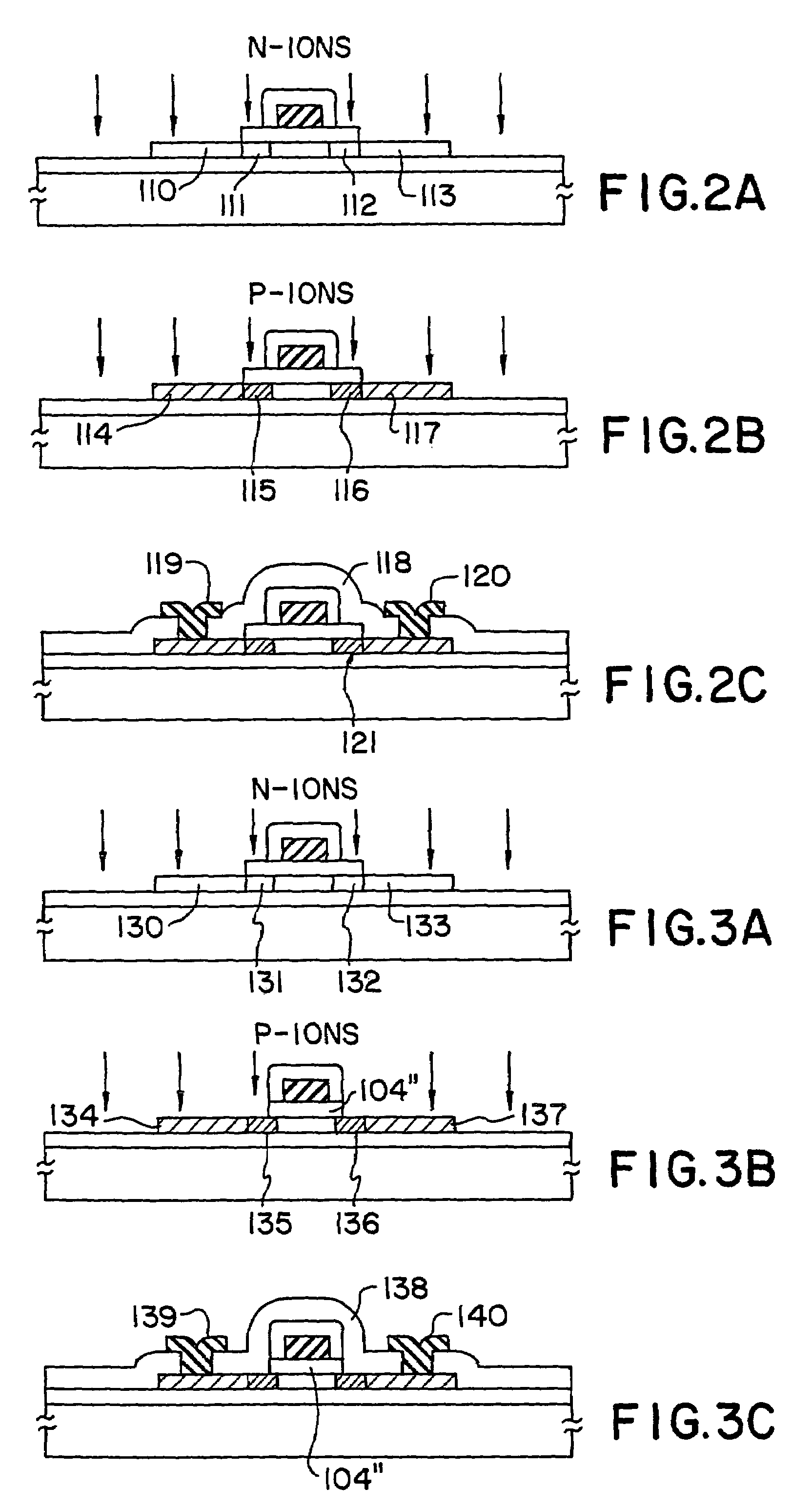Method of manufacturing a TFT with laser irradiation
a thin film transistor and laser irradiation technology, applied in the direction of transistors, electrical devices, semiconductor devices, etc., can solve the problems of uniform quality of tfts thus obtained, and achieve the effects of uniform device characteristics, high yield and high resistan
- Summary
- Abstract
- Description
- Claims
- Application Information
AI Technical Summary
Benefits of technology
Problems solved by technology
Method used
Image
Examples
example 1
[0034]A silicon oxide film having a thickness of 1,000 to 3,000 Å is formed as a base oxide film 102 on a Corning 7059 substrate 101 (300×400 mm or 100×100 mm in size) by sputtering in an oxygen atmosphere. For mass production, the film is deposited by decomposing TEOS using plasma CVD. A mono-layered film of aluminum nitride or a multilayered film of silicon oxide and aluminum nitride can be used as the base oxide film. The aluminum nitride film is formed by reactive sputtering in a nitrogen atmosphere.
[0035]An amorphous silicon film is deposited thereafter at a thickness of 300 to 5,000 Å, preferably, 500 to 1,000 Å, by plasma CVD or LPCVD, and is crystallized thereafter by allowing it to stand still in a reduction atmosphere in a temperature range of 550 to 600° C. for 24 hours. The crystallization may be effected by laser irradiation. Thus crystallized silicon film is patterned to form an island-like region 103. A silicon oxide film 104 having a thickness of 700 to 1,500 Å is fo...
example 2
[0049]A base film 102, an active layer 103, a gate insulating film 104′, a gate electrode 105, and an anodic oxide 108 are formed on a glass substrate 101 by processes similar to that described in Example 1 (FIG. 1E).
[0050]Nitrogen ions are introduced in a self-alignment into the active layer 103 using the gate electrode and the gate insulating film as masks. The dose is 1×1014 to 3×1016 cm−2, for example, 2×1015 cm−2. An accelerating voltage is 50 to 100 kV, for example, 80 kV. As a result, almost no nitrogen atoms are introduced into the regions 130 and 133 (the concentration of nitrogen is 1×1019 atoms cm−3 or less in SIMS), but nitrogen atoms are introduced into the regions 131 and 132 at a concentration of 5×1019 to 2×1021 atoms cm−3 depending on the depth (FIG. 3A).
[0051]The gate insulating film 104′ is etched thereafter to form a gate insulating film 104″ by using the anodic oxide 108 as a mask. An N-type impurity is introduced into the active layer thereafter by ion doping a...
example 3
[0054]Referring to FIGS. 5A to SF, a method for fabricating an N-channel TFT is described below. First referring to the processes shown in FIGS. 1A and 1B, a base oxide film 202, an island-like semiconductor (e.g., a crystalline silicon semiconductor) region 203, a silicon oxide film 204, and a gate electrode 205 comprising an aluminum film (200 nm to 1 μm in thickness) are formed on a substrate 201 having an insulating surface (e.g., a Corning 7059 glass), and a porous anodic oxide 206 (3,000 Å to 1 μm in thickness, e.g., 5,000 Å) is formed in both sides of the gate electrode 205 (FIG. 5A).
[0055]A barrier anodic oxide 207 (1,000 to 2,500 Å in thickness) is formed thereafter in the same manner as in the process described in Example 1 (FIG. 5B).
[0056]The silicon oxide film 204 is etched using the anodic oxide 206 as the mask, to form a gate insulating film 204′. Then, the anodic oxide film 206 is removed by etching using the anodic oxide film 207 as the mask. Impurity (phosphorus) is...
PUM
| Property | Measurement | Unit |
|---|---|---|
| distance | aaaaa | aaaaa |
| glass transition temperature | aaaaa | aaaaa |
| thickness | aaaaa | aaaaa |
Abstract
Description
Claims
Application Information
 Login to View More
Login to View More - R&D
- Intellectual Property
- Life Sciences
- Materials
- Tech Scout
- Unparalleled Data Quality
- Higher Quality Content
- 60% Fewer Hallucinations
Browse by: Latest US Patents, China's latest patents, Technical Efficacy Thesaurus, Application Domain, Technology Topic, Popular Technical Reports.
© 2025 PatSnap. All rights reserved.Legal|Privacy policy|Modern Slavery Act Transparency Statement|Sitemap|About US| Contact US: help@patsnap.com



